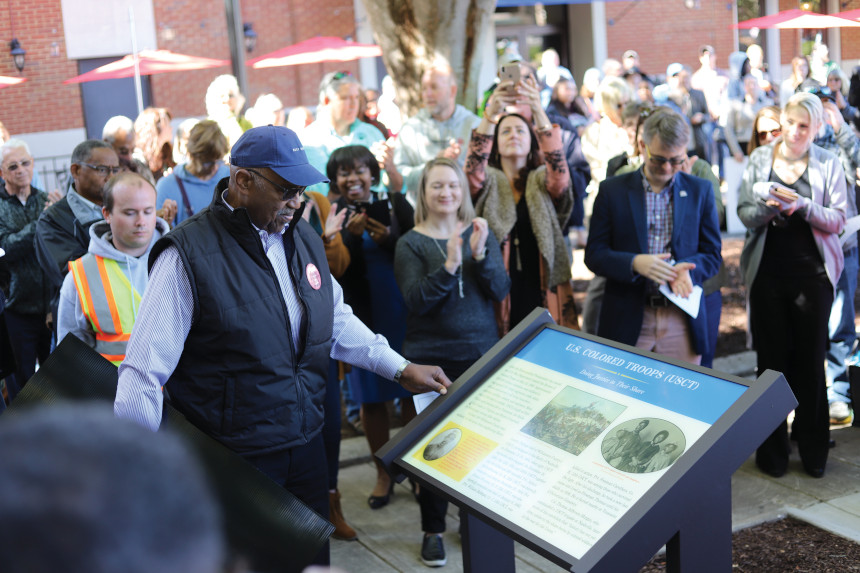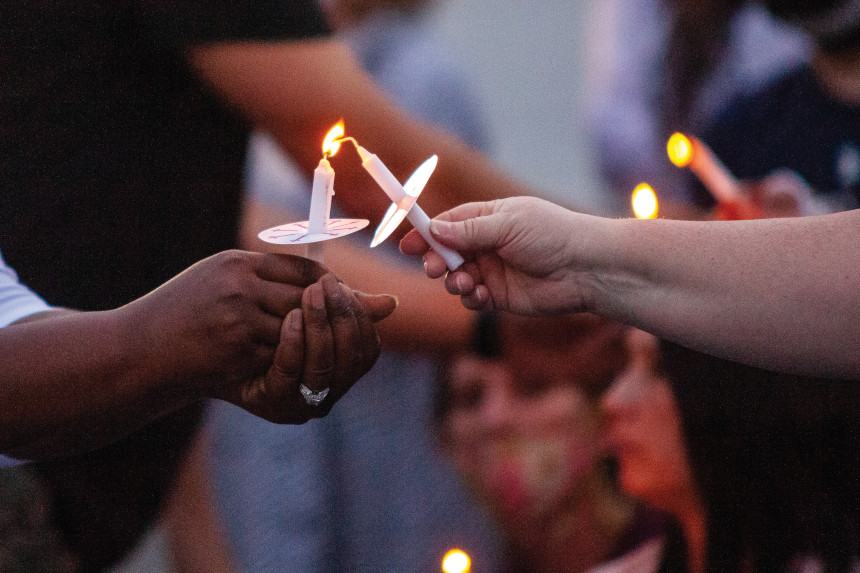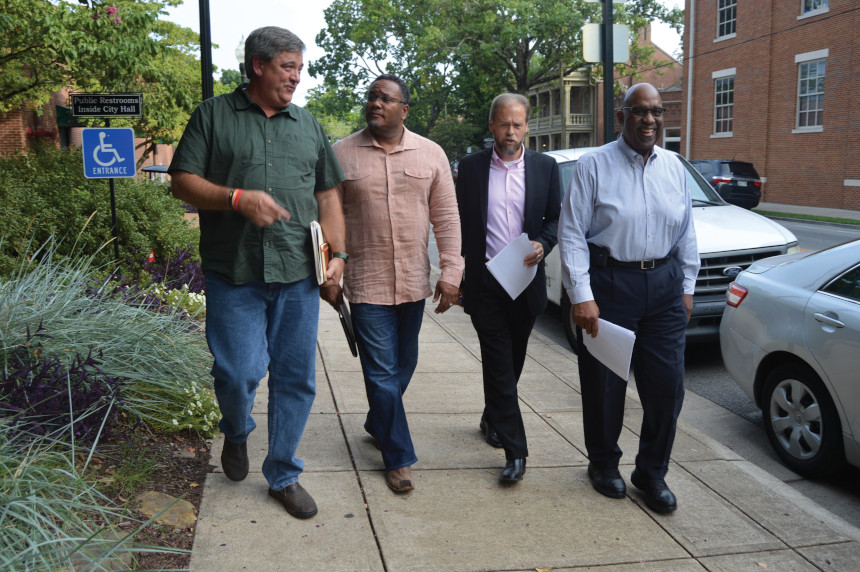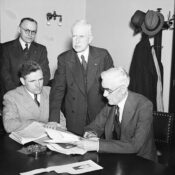Our questions about history influence the conversation about how we ought to publicly remember the past. With nearly 1,800 memorials, statues, and other public symbols of the Confederacy across the United States, scrutiny of historical figures has grown as more institutions, historians, and individuals reassess our past in light of our current values.
Following the August 2017 white-supremacist Unite the Right rally in Charlottesville, Virginia, many communities turned years of discussion about their Confederate monuments into action. Some statues were removed and some remained standing. In other cases, monuments were relocated to museums or private collections. Schools were renamed, and even the Mississippi state flag was redesigned without the inclusion of the Confederate battle flag in its canton.
After the Charlottesville tragedy, a group of people gathered in the public square of downtown Franklin, Tennessee, to hold a prayer vigil. Located in central Tennessee’s Williamson County, a little over 20 miles south of Nashville, Franklin is a key site in the American Civil War — home to the Battle of Franklin of November 1864. Among those who attended the vigil were pastor Kevin Riggs of Franklin Community Church and Eric Jacobson, historian and CEO of the Battle of Franklin Trust. Riggs told reporters it was time to discuss what to do with the city’s own Civil War soldier statue, whether that meant relocating or removing it.
Any attempt to remove the statue would come up against the Tennessee Heritage Protection Act, enacted in 2013. Efforts to remove, relocate, or rename a memorial require a two-thirds vote from the board of the Tennessee Historical Commission, the majority of whose members are appointed by the governor. As Riggs and Jacobson discussed potential options, Jacobson shared his concern that it was unlikely the Commission would grant approval for the statue’s removal, and suggested they consider leaving the monument up as but one image seen by a wider lens that included the stories of Black history in and around Franklin.
“‘What you’re saying sounds good,’ I told him,” said Riggs. “But since we’re both white, I felt we needed to talk it through with our African American brothers first and see what they thought about the idea.”
They contacted local pastors Hewitt Sawyers of West Harpeth Primitive Baptist Church and Chris Williamson of Strong Tower Bible Church to share their thoughts about what they referred to as Plan B. “Going with Plan B to begin with, rather than focusing our efforts on the Tennessee Historical Commission, put me in the difficult position of suggesting to two Black pastors that we shouldn’t tear the statue down,” says Jacobson. “But my intention was never to defend the statue itself.”
Installed in 1899, the marble sculpture — a monument to Confederate soldiers — stands 37 feet above the ground in the city’s public square, atop a column of marble and granite. As with many other statues of its kind, its installation more than 20 years after the end of the Reconstruction era is defended as a delayed recognition of history by some, but considered a symbol of white supremacy and oppression by others.
“Apathy is knowing that there’s something terrible going on but choosing to stay silent. This project is another small step to confront the ghosts of our past.”
Discussions among the group began in earnest, often over coffee at The Coffee House at Second and Bridge. “I just wasn’t in Eric’s corner at the time,” says Sawyers. “But as we talked about how this Confederate statue was memorializing soldiers who had died, not a representation of a specific individual, it was easier to consider how we could show a more complete acknowledgement of history, rather than tearing something down.”
Slowly, after nearly a year, a proposal began to come together to add context around the monument to try to foster unity instead of division. It included placing five markers in and near the public square recognizing the suffering and advancement of African Americans in Franklin before, during, and after the Civil War. One indicates the location of an 1809 courthouse and nearby market house, both of which played roles in the sale of enslaved people. Another tells of the role of U.S. Colored Troops (USCT) in the Civil War and the stories of local USCT soldiers. A third marker details the events of the Battle of Franklin. The story of the 1867 Franklin Riot, which broke out after a white Conservative shot at members of the Colored League (African American Republicans), is told on another marker. The fifth marker describes Reconstruction and the lives of three former enslaved people who became respected community members, representing larger contributions to the region by people who had previously been held in bondage.
In addition to the markers, the group proposed that a full-scale statue of a USCT soldier be erected in the public square in a place of equal nobility across from the Confederate monument. “Representation matters, telling the truth matters, and to behold the image of a Black man in a position of prominence in our city for the first time allows us to truly recognize that there were people who were still enslaved but who fought for our freedom, for their freedom, for the freedom of the country,” says Williamson. “No country can be free that enslaves people.”
It was of paramount importance to the group that the sculptor be African American. But it was also key that the artist have Tennessee roots. Williamson learned from one of the members of his church that a sculptor in Ohio, Joe F. Howard, spent his early life in Paris, Tennessee. “We didn’t want it to be a traditional, slick statue that’s on a pedestal way up high,” says Williamson. “It should be down where the people are, where they can be close enough to view his face and see his dignity, his value, his courage. The soldier’s pants are ripped, his face has deep lines, and yet his eyes speak of perseverance. His foot on a tree stump symbolizes that the tree of racism and bondage, where my ancestors were whipped on and sold under, has been cut down.”
Before the markers and USCT statue could be approved, however, the group needed to convince the Franklin Board of Mayor and Aldermen that this compromise was the precise action necessary to bring people together, as well as teach Franklin’s complete history. They began to refer to the project as telling the city’s “Fuller Story.”

“Some of the people we talked with during this process, who invited us into their homes and served glasses of iced tea, tried to get us to just leave it all alone,” says Sawyers. “They claimed the Confederate statue was part of Franklin’s heritage, not a symbol supporting slavery. They worried that if we placed markers in the square, anyone could come along and do the same, diminishing the importance of the Confederate monument.”
But all encounters weren’t so courteous. When word got out that Riggs had initially thought the Confederate monument should be removed, he began to receive threats. “Some were perhaps just angry words, but there were some serious threats,” he says. “But I wasn’t going to back down.”
“There wasn’t a single piece of this project that’s been easy, but history has always been messy,” says Jacobson. “If we didn’t choose to look at the truth, we’d continue down this path of intentionally not knowing as a culture. Luckily, the City of Franklin understood early on.”
Eventually when residents learned about the group’s plans to tell the “Fuller Story,” some of the people who disagreed seemed to give in — not in full support, but satisfied in the knowledge that the original monument in the public square would remain. On the other side, some citizens who had wanted the statue removed took solace in learning about plans for the new USCT statue.
“Having this statue of a U.S. Colored Troops soldier right in front of the courthouse, where some of the soldiers entered to sign up for the Union Army so they could fight for their own freedom, is an important acknowledgement of our history,” says Sawyers, who graduated from high school in 1965, two years before his school was desegregated. He still remembers when the courthouse had bathrooms and water fountains marked “colored.”
“The monument is a manifestation of a deeper issue,” says Anthony Hendricks, cofounder and director of The Public, a local anti-racism organization. “I would like to see it removed, but I know that taking it away won’t change the issue of white supremacy. Still, the Fuller Story project is a step in the right direction, and what they’ve done in the past few years is remarkable. I’m excited about the USCT soldier, and I plan to be there when it’s dedicated.”
“Really good people on this issue can disagree,” says Franklin resident Shanera Williamson (no relation to Pastor Chris Williamson). “I’m grateful for the history lesson the Fuller Story represents, but I don’t think it goes far enough to dismantle the supremacist beliefs that erected the Confederate monument in our town square. It’s a constant reminder to African Americans that we are not welcome.”
On the other side of the issue, the United Daughters of the Confederacy (UDC) bluntly opposed the project. They claimed to own the entire square and threatened to sue the city if the markers and statue were put in place. In response, the Board of Mayor and Aldermen filed a declaratory judgment acknowledging that the UDC owned the monument, but only the monument and the land beneath it, while the City of Franklin owned and maintained the square.
After a unanimous vote by the Franklin Board of Mayor and Aldermen in support of the Fuller Story project, the five markers were unveiled in October 2019. Nine months later, in July 2020, the City of Franklin settled its lawsuit with the UDC. Shortly after that, in November 2020, the design, placement, and installation of the USCT statue was approved.
“To behold the image of a Black man in a position of prominence in our city for the first time allows us to truly recognize that there were people who were still enslaved but who fought for our freedom.”
Just how did such a delicate and nuanced compromise come to fruition in a town where emotions ran high on both sides of the issue? The answer: a lot of outreach, a lot of discussion, and a great deal of patience. “Planting a seed in someone’s mind works better than pushing them to change their mind,” says Jacobson. “Expanding our story to include the complex history in and around Franklin is just called the truth. Apathy is knowing that there’s something terrible going on but choosing to stay silent. This project is another small step to confront the ghosts of our past.”
Taking that step required raising funds for the five markers, the statue, and its base, at a cost of $160,000. The statue will be dedicated in October 2021, two years after the five markers were installed.
“It’s important to me that this movement really started and has been pushed by the churches,” says Riggs. “As the conscience of the community, we wanted an opportunity to unite instead of divide. Do we have the courage and the wisdom to tell more of our story?”
Sawyers agrees. “I’m encouraged by the city’s support to serve all of its residents,” he says. “I think this is a better way to help people understand what our collective history really is. Many school kids today don’t know that history at all.”

words of the organizer — that “we all stand in solidarity against any kind of injustice.” (Matt Masters/Williamson Home Page)
The Fuller Story founders view their experience as an opportunity for other Southern cities in similar circumstances to consider using as a model. Telling the story this late in our country’s history is difficult, but they believe the journey has to start with an honest look at what values we want our communities to reflect.
“I think we have a unique opportunity here to do something positive,” says Pastor Williamson. “To the people who aren’t happy with this solution, I say, ‘Just wait, let’s see what happens when we’re done.’”
Jill K. Robinson is an award-winning writer whose work has appeared in AFAR, National Geographic, Travel + Leisure, Conde Nast Traveler, and Outside, among many others. For more, visit dangerjillrobinson.com.
This article is featured in the September/October 2021 issue of The Saturday Evening Post. Subscribe to the magazine for more art, inspiring stories, fiction, humor, and features from our archives.
Featured image: A delicate compromise: Four men — (from left) pastor Kevin Riggs, pastor Chris Williamson, historian Eric Jacobson, and pastor Hewitt Sawyers — created the “Fuller Story” project, which they hope can be a model for other communities struggling to reckon with their Confederate history. (Photo by Kerri Bartlett/Williamson Herald)
Become a Saturday Evening Post member and enjoy unlimited access. Subscribe now




Comments
The Fuller Story in TN. seems to have been well thought out on from every aspect and angle. It seems like a model other cities and states can adopt for successful healing in moving forward as a nation, while not denying or forgetting the past. It’s a delicate balance, but must be done so we’re not continuously always back to square one with open wounds in this country.